NCERT Solutions for Chapter 6 Triangles Class 10 Maths
Book Solutions1
(i) All circles are __________. (congruent, similar)
(ii) All squares are __________. (similar, congruent)
(iii) All __________ triangles are similar. (isosceles, equilateral)
(iv) Two polygons of the same number of sides are similar, if (a) their corresponding angles are __________ and (b) their corresponding sides are __________. (equal, proportional)
Answer
(i) Similar(ii) Similar
(iii) Equilateral
(iv) (a) Equal, (b) Proportional
2
(i) Similar figures
(ii) Non-similar figures
Answer
(i) Two twenty-rupee notes, Two two rupees coins.(ii) One rupee coin and five rupees coin, One rupee not and ten rupees note.
3
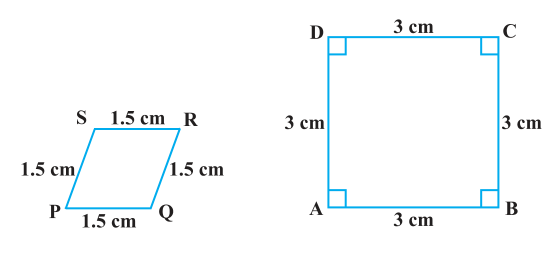
Answer
The given two figures are not similar because their corresponding angles are not equal.1
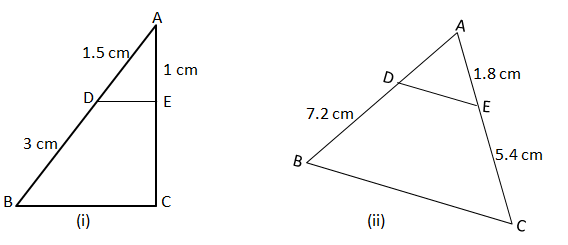
Answer
(i) In △ ABC, DE || BC (Given)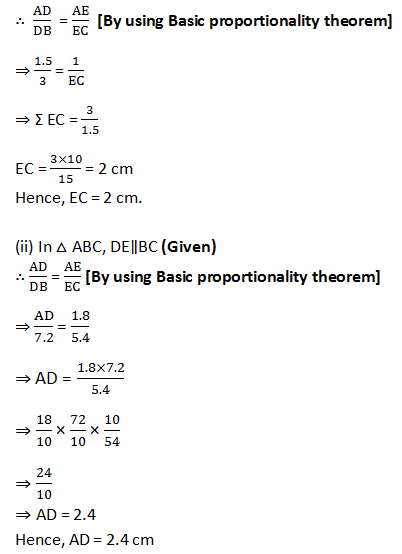
2
E and F are points on the sides PQ and PR respectively of a ΔPQR. For each of the following cases, state whether EF || QR.
(i) PE = 3.9 cm, EQ = 3 cm, PF = 3.6 cm and FR = 2.4 cm
(ii) PE = 4 cm, QE = 4.5 cm, PF = 8 cm and RF = 9 cm
(iii) PQ = 1.28 cm, PR = 2.56 cm, PE = 0.18 cm and PF = 0.63 cm
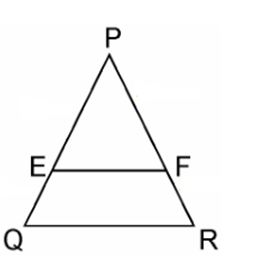
Answer
In ΔPQR, E and F are two points on side PQ and PR respectively.
(i) PE = 3.9 cm, EQ = 3 cm(Given)
PF = 3.6 cm, FR = 2,4 cm (Given)

(ii) PE = 4 cm, QE = 4.5 cm, PF = 8cm, RF = 9cm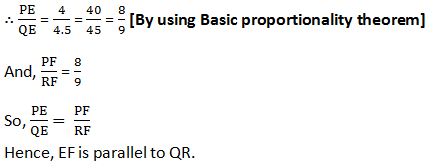
(iii) PQ = 1.28 cm, PR = 2.56 cm, PE = 0.18 cm, PF = 0.36 cm (Given)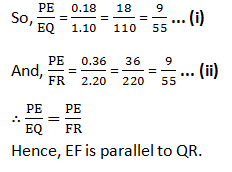
3
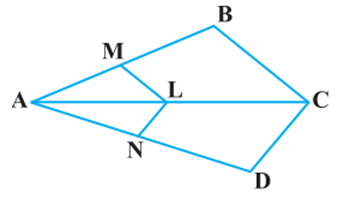
Answer
In the given figure, LM || CBBy using basic proportionality theorem, we get,
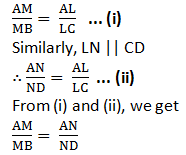
4
In the fig 6.19, DE||AC and DF||AE. Prove that
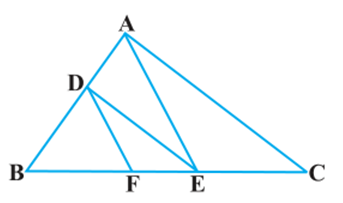
Answer
In ΔABC, DE || AC (Given)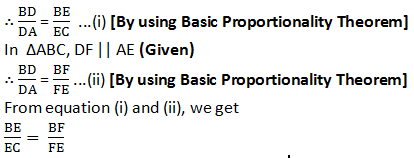
5
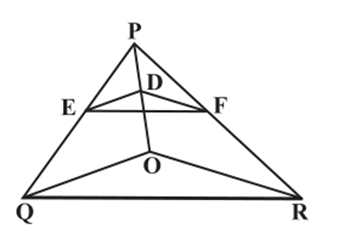
Answer
In ΔPQO, DE || OQ (Given)
6
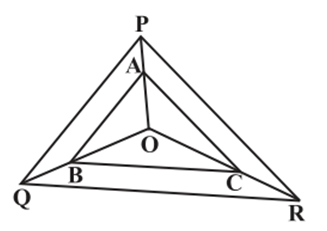
Answer
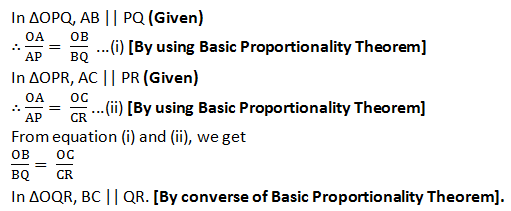
7
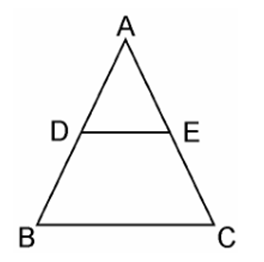
Answer
Given:
ΔABC in which D is the mid point of AB such that AD=DB.
A line parallel to BC intersects AC at E as shown in above figure such that DE || BC.
To Prove: E is the mid point of AC.
Proof: D is the mid-point of AB.
∴ AD=DB
∴ AE =EC
Hence, E is the mid point of AC.
8
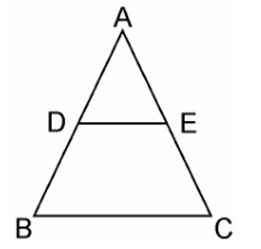
Answer
Given:
ΔABC in which D and E are the mid points of AB and AC respectively such that AD=BD and AE=EC.
To Prove: DE || BC
Proof: D is the mid point of AB (Given)
∴ AD=DB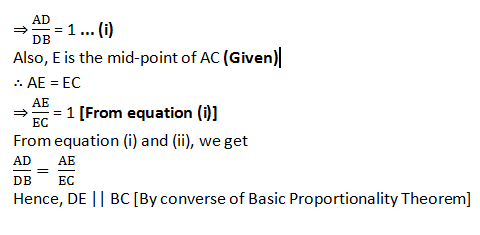
9

Answer
Given:
ABCD is a trapezium in which AB || DC in which diagonals AC and BD intersect each other at O.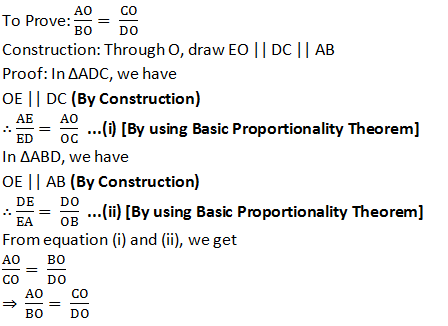
10
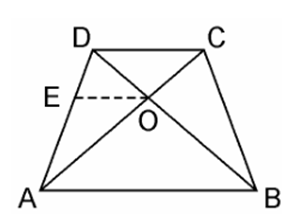
Answer
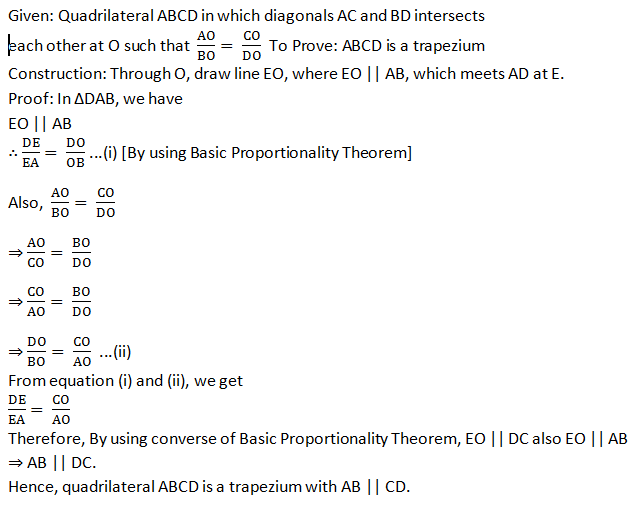
1

Answer
(i) In ΔABC and ΔPQR, we have
∠A = ∠P = 60° (Given)
∠B = ∠Q = 80°(Given)
∠C = ∠R = 40°(Given)
∴ ΔABC ~ ΔPQR (AAA similarity criterion)
(ii) In ΔABC and ΔPQR, we have![]()
∴ ΔABC ~ ΔQRP (SSS similarity criterion)
(iii) In ΔLMP and ΔDEF, we have
LM = 2.7, MP = 2, LP = 3, EF = 5, DE = 4, DF = 6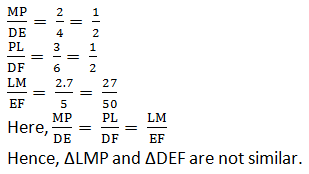
(iv) In ΔMNL and ΔQPR, we have![]()
∠M = ∠Q = 70°
∴ ΔMNL ~ ΔQPR (SAS similarity criterion)
(v) In ΔABC and ΔDEF, we have
AB = 2.5, BC = 3, ∠A = 80°, EF = 6, DF = 5, ∠F = 80°
(vi) In ΔDEF,we have
∠D + ∠E + ∠F = 180° (sum of angles of a triangle)
⇒ 70° + 80° + ∠F = 180°
⇒ ∠F = 180° - 70° - 80°
⇒ ∠F = 30°
In PQR, we have
∠P + ∠Q + ∠R = 180 (Sum of angles of Δ)
⇒ ∠P + 80° + 30° = 180°
⇒ ∠P = 180° - 80° -30°
⇒ ∠P = 70°
In ΔDEF and ΔPQR, we have
∠D = ∠P = 70°
∠F = ∠Q = 80°
∠F = ∠R = 30°
Hence, ΔDEF ~ ΔPQR (AAA similarity criterion)
2
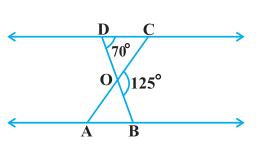
Answer
DOB is a straight line.Therefore, ∠DOC + ∠ COB = 180°
⇒ ∠DOC = 180° - 125°
= 55°
In ΔDOC,
∠DCO + ∠ CDO + ∠ DOC = 180°
(Sum of the measures of the angles of a triangle is 180º.)
⇒ ∠DCO + 70º + 55º = 180°
⇒ ∠DCO = 55°
It is given that ΔODC ~ ΔOBA.
∴ ∠OAB = ∠OCD [Corresponding angles are equal in similar triangles.]
⇒ ∠ OAB = 55°
∴ ∠OAB = ∠OCD [Corresponding angles are equal in similar triangles.]
⇒ ∠OAB = 55°
3

Answer
In ΔDOC and ΔBOA,∠CDO = ∠ABO [Alternate interior angles as AB || CD]
∠DCO = ∠BAO [Alternate interior angles as AB || CD]
∠DOC = ∠BOA [Vertically opposite angles]
∴ ΔDOC ~ ΔBOA [AAA similarity criterion]

4
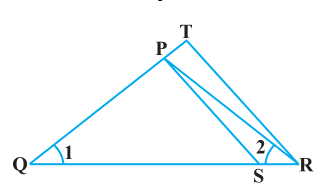
Answer
In ΔPQR, ∠PQR = ∠PRQ∴ PQ = PR ...(i)
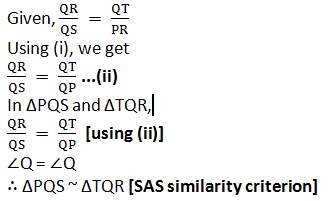
5
ΔRPQ ~ ΔRTS.
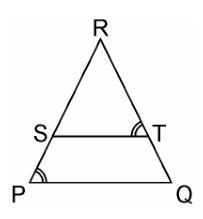
Answer
In ΔRPQ and ΔRST,∠RTS = ∠QPS (Given)
∠R = ∠R (Common angle)
∴ ΔRPQ ~ ΔRTS (By AA similarity criterion)
6

Answer
It is given that ΔABE ≅ ΔACD.∴ AB = AC [By cpct] ...(i)
And, AD = AE [By cpct] ...(ii)
In ΔADE and ΔABC,
∠A = ∠A [Common angle]
∴ ΔADE ~ ΔABC [By SAS similarity criterion]
7
(i) ΔAEP ~ ΔCDP
(ii) ΔABD ~ ΔCBE
(iii) ΔAEP ~ ΔADB
(iv) ΔPDC ~ ΔBEC

Answer
(i) In ΔAEP and ΔCDP,
∠AEP = ∠CDP(Each 90°)
∠APE = ∠CPD(Vertically opposite angles)
Hence, by using AA similarity criterion,
ΔAEP ~ ΔCDP
(ii) In ΔABD and ΔCBE,
∠ADB = ∠CEB (Each 90°)
∠ABD = ∠CBE (Common)
Hence, by using AA similarity criterion,
ΔABD ~ ΔCBE
(iii) In ΔAEP and ΔADB,
∠AEP = ∠ADB (Each 90°)
∠PAE = ∠DAB (Common)
Hence, by using AA similarity criterion,
ΔAEP ~ ΔADB
(iv) In ΔPDC and ΔBEC,
∠PDC = ∠BEC (Each 90°)
∠PCD = ∠BCE (Common angle)
Hence, by using AA similarity criterion,
ΔPDC ~ ΔBEC
8
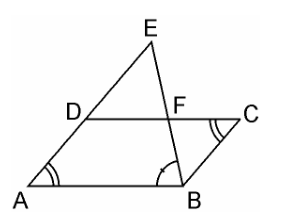
Answer
In ΔABE and ΔCFB,∠A = ∠C (Opposite angles of a parallelogram)
∠AEB = ∠CBF (Alternate interior angles as AE || BC)
∴ ΔABE ~ ΔCFB (By AA similarity criterion)
9
(i) ΔABC ~ ΔAMP
(ii) CA/PA = BC/MP
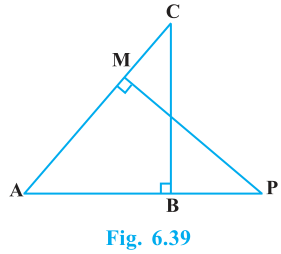
Answer
(i) In ΔABC and ΔAMP, we have
∠A = ∠A (common angle)
∠ABC = ∠AMP = 90° (each 90°)
∴ ΔABC ~ ΔAMP (By AA similarity criterion)
(ii) As, ΔABC ~ ΔAMP (By AA similarity criterion)
If two triangles are similar then the corresponding sides are equal,![]()
10
CD and GH are respectively the bisectors of ∠ACB and ∠EGF such that D and H lie on sides AB and FE of ΔABC and ΔEFG respectively. If ΔABC ~ ΔFEG, Show that:
(i) CD/GH = AC/FG
(ii) ΔDCB ~ ΔHGE
(iii) ΔDCA ~ ΔHGF

Answer
(i) It is given that ΔABC ~ ΔFEG.
∴ ∠A = ∠F, ∠B = ∠E, and ∠ACB = ∠FGE
∠ACB = ∠FGE
∴ ∠ACD = ∠FGH (Angle bisector)
And, ∠DCB = ∠HGE (Angle bisector)
In ΔACD and ΔFGH,
∠A = ∠F (Proved above)
∠ACD = ∠FGH (Proved above)
∴ ΔACD ~ ΔFGH (By AA similarity criterion)![]()
(ii) In ΔDCB and ΔHGE,
∠DCB = ∠HGE (Proved above)
∠B = ∠E (Proved above)
∴ ΔDCB ~ ΔHGE (By AA similarity criterion)
(iii) In ΔDCA and ΔHGF,
∠ACD = ∠FGH (Proved above)
∠A = ∠F (Proved above)
∴ ΔDCA ~ ΔHGF (By AA similarity criterion)
11
In the following figure, E is a point on side CB produced of an isosceles triangle ABC with AB = AC. If AD ⊥ BC and EF ⊥ AC, prove that ΔABD ~ ΔECF.

Answer
It is given that ABC is an isosceles triangle.∴ AB = AC
⇒ ∠ABD = ∠ECF
In ΔABD and ΔECF,
∠ADB = ∠EFC (Each 90°)
∠BAD = ∠CEF (Proved above)
∴ ΔABD ~ ΔECF (By using AA similarity criterion)
12
Sides AB and BC and median AD of a triangle ABC are respectively proportional to sides PQ and QR and median PM of ΔPQR (see Fig 6.41). Show that ΔABC ~ ΔPQR.
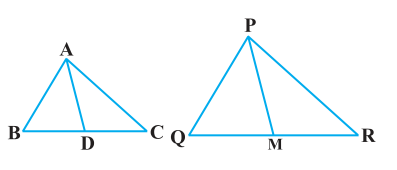
Answer
Given:
ΔABC and ΔPQR, AB, BC and median AD of ΔABC are proportional to sides PQ, QR and median PM of ΔPQR
13
Answer
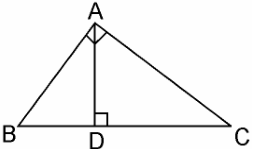
∠ADC = ∠BAC(Given)
∠ACD = ∠BCA(Common angle)
∴ ΔADC ~ ΔBAC (By AA similarity criterion)
We know that corresponding sides of similar triangles are in proportion.

14
Answer

To Prove: ΔABC ~ ΔPQR
Construction: Produce AD to E so that AD = DE. Join CE, Similarly produce PM to N such that PM = MN, also Join RN.
Proof: In ΔABD and ΔCDE, we have
AD = DE [By Construction]
BD = DC [∴ AP is the median]
and, ∠ADB = ∠CDE [Vertically opp. angles]
∴ ΔABD ≅ ΔCDE [By SAS criterion of congruence]
⇒ AB = CE [CPCT] ...(i)
Also, in ΔPQM and ΔMNR, we have
PM = MN [By Construction]
QM = MR [∴ PM is the median]
and, ∠PMQ = ∠NMR [Vertically opposite angles]
∴ ΔPQM = ΔMNR [By SAS criterion of congruence]
⇒ PQ = RN [CPCT] ...(ii)
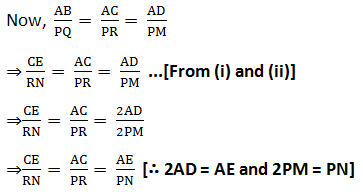
∴ ΔACE ~ ΔPRN [By SSS similarity criterion]
Therefore, ∠2 = ∠4
Similarly, ∠1 = ∠3
∴ ∠1 + ∠2 = ∠3 + ∠4
⇒ ∠A = ∠P ...(iii)
Now, In ΔABC and ΔPQR, we have

15
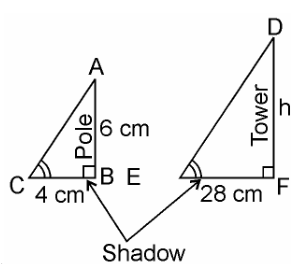
Answer
Length of the vertical pole = 6m (Given)Shadow of the pole = 4 m (Given)
Let Height of tower = h m
Length of shadow of the tower = 28 m (Given)
In ΔABC and ΔDEF,
∠C = ∠E (angular elevation of sum)
∠B = ∠F = 90°
∴ ΔABC ~ ΔDEF (By AA similarity criterion)
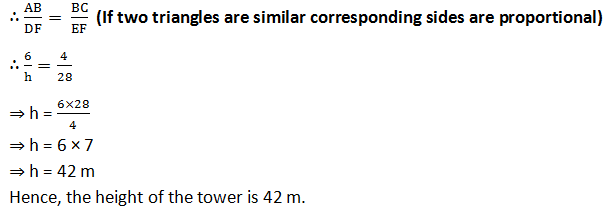
16
Answer
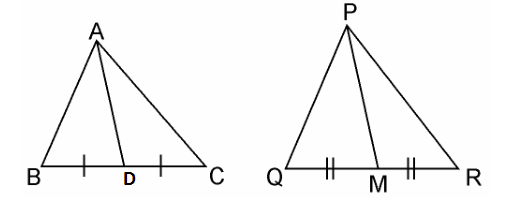

1
Answer
It is given that,Area of ΔABC = 64 cm2
Area of ΔDEF = 121 cm2
EF = 15.4 cm
and, ΔABC ~ ΔDEF
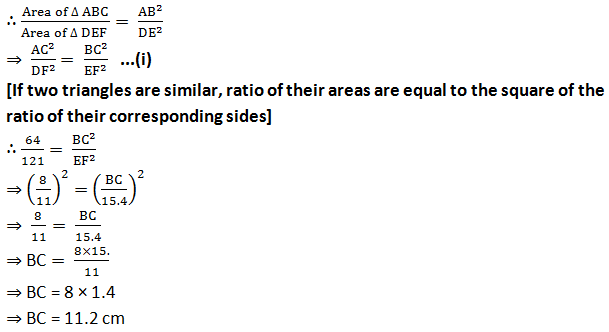
2
Answer
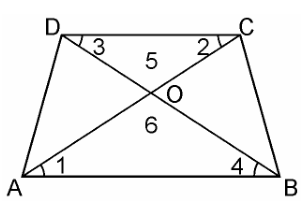
In ΔAOB and ΔCOD, we have
∠1 = ∠2(Alternate angles)
∠3 = ∠4(Alternate angles)
∠5 = ∠6(Vertically opposite angle)
∴ ΔAOB ~ ΔCOD [By AAA similarity criterion]
Now, Area of (ΔAOB)/Area of (ΔCOD)
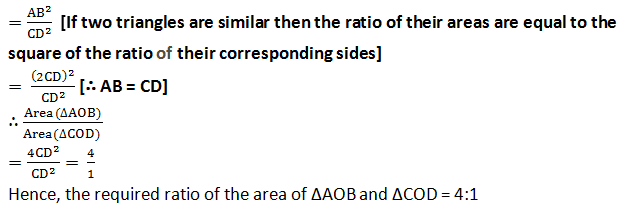
3
Answer
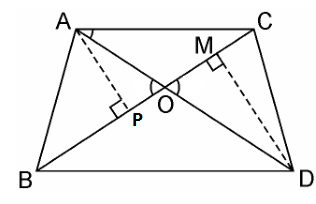

4
Answer
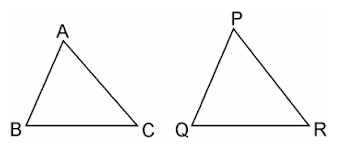
Given: ΔABC and ΔPQR are similar and equal in area.
To Prove: ΔABC ≅ ΔPQR
Proof: Since, ΔABC ~ ΔPQR
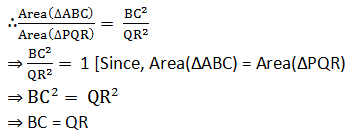
Similarly, we can prove that
AB = PQ and AC = PR
Thus, ΔABC ≅ ΔPQR [BY SSS criterion of congruence]
5
Answer
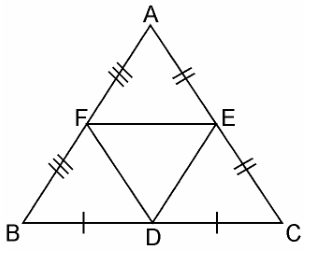
Given: D, E and F are the mid-points of the sides AB, BC and CA respectively of the ΔABC.
To Find: area(ΔDEF) and area(ΔABC)
Solution: In ΔABC, we have
F is the mid point of AB (Given)
E is the mid-point of AC (Given)
So, by the mid-point theorem, we have

∴ BDEF is parallelogram [Opposite sides of parallelogram are equal and parallel]
Similarly in ΔFBD and ΔDEF, we have
FB = DE (Opposite sides of parallelogram BDEF)
FD = FD (Common)
BD = FE (Opposite sides of parallelogram BDEF)
∴ ΔFBD ≅ ΔDEF
Similarly, we can prove that
ΔAFE ≅ ΔDEF
ΔEDC ≅ ΔDEF
If triangles are congruent,then they are equal in area.
So, area(ΔFBD) = area(ΔDEF) ...(i)
area(ΔAFE) = area(ΔDEF) ...(ii)
and, area(ΔEDC) = area(ΔDEF) ...(iii)
Now, area(ΔABC) = area(ΔFBD) + area(ΔDEF) + area(ΔAFE) + area(ΔEDC) ...(iv)
area(ΔABC) = area(ΔDEF) + area(ΔDEF) + area(ΔDEF) + area(ΔDEF)

6
Answer
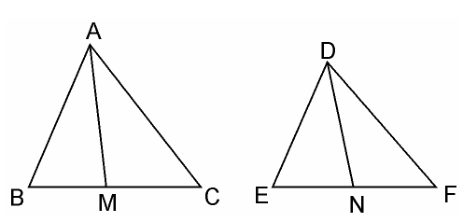
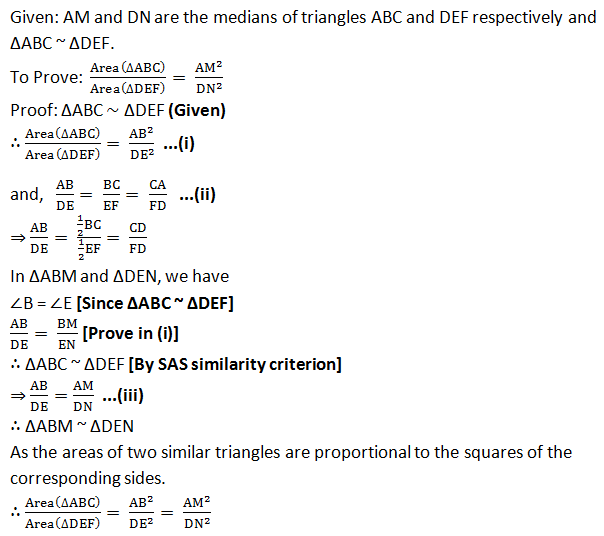
7
Answer
Given: ABCD is a square whose one diagonal is AC. ΔAPC and ΔBQC are two equilateral triangles described on the diagonals AC and side BC of the square ABCD.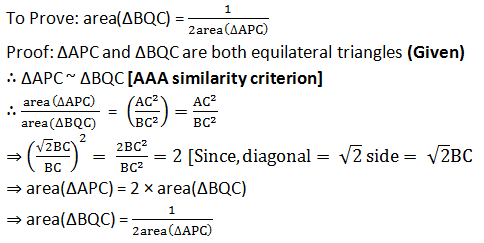
8
Q8. ABC and BDE are two equilateral triangles such that D is the mid-point of BC. Ratio of the area of triangles ABC and BDE is
(A) 2 : 1
(B) 1 : 2
(C) 4 : 1
(D) 1 : 4
Answer
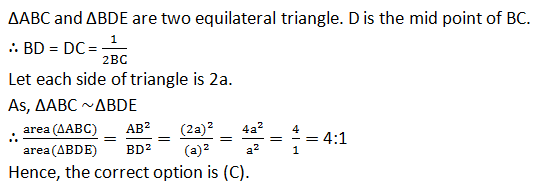
9
(A) 2 : 3
(B) 4 : 9
(C) 81 : 16
(D) 16 : 81
Answer
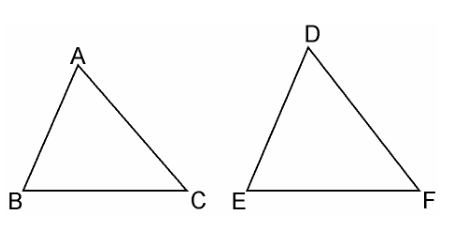
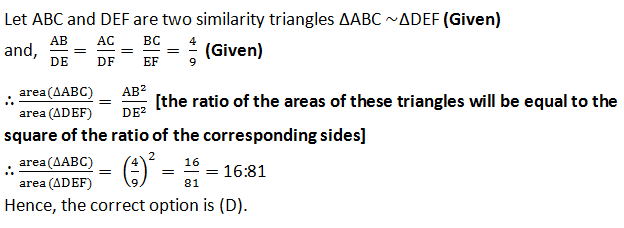
1
(i) 7 cm, 24 cm, 25 cm
(ii) 3 cm, 8 cm, 6 cm
(iii) 50 cm, 80 cm, 100 cm
(iv) 13 cm, 12 cm, 5 cm
Answer
(i) Given that the sides of the triangle are 7 cm, 24 cm, and 25 cm.
Squaring the lengths of these sides, we will get 49, 576, and 625.
49 + 576 = 625
(7)2 + (24)2 = (25)2
The sides of the given triangle are satisfying Pythagoras theorem.Hence, it is right angled triangle.
Length of Hypotenuse = 25 cm
(ii) Given that the sides of the triangle are 3 cm, 8 cm, and 6 cm.
Squaring the lengths of these sides, we will get 9, 64, and 36.
However, 9 + 36 ≠ 64
Or, 32 + 62 ≠ 82
Clearly, the sum of the squares of the lengths of two sides is not equal to the square of the length of the third side.
Therefore, the given triangle is not satisfying Pythagoras theorem.
(iii) Given that sides are 50 cm, 80 cm, and 100 cm.
Squaring the lengths of these sides, we will get 2500, 6400, and 10000.
However, 2500 + 6400 ≠ 10000
Or, 502 + 802 ≠ 1002
Clearly, the sum of the squares of the lengths of two sides is not equal to the square of the length of the third side.
Therefore, the given triangle is not satisfying Pythagoras theorem.
Hence, it is not a right triangle.
(iv) Given that sides are 13 cm, 12 cm, and 5 cm.
Squaring the lengths of these sides, we will get 169, 144, and 25.
Clearly, 144 +25 = 169
Or, 122 + 52 = 132
The sides of the given triangle are satisfying Pythagoras theorem.
Therefore, it is a right triangle.
Length of the hypotenuse of this triangle is 13 cm.
2
Answer
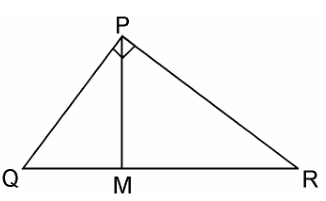
Given: ΔPQR is right angled at P is a point on QR such that PM ⊥QR.
To prove: PM2 = QM × MR
Proof: In ΔPQM, we have
PQ2 = PM2 + QM2 [By Pythagoras theorem]
Or, PM2 = PQ2 − QM2 ...(i)
In ΔPMR, we have
PR2 = PM2 + MR2 [By Pythagoras theorem]
Or, PM2 = PR2 − MR2 ...(ii)
Adding (i) and (ii), we get
2PM2 = (PQ2 + PM2) - (QM2 + MR2
= QR2 − QM2 − MR2 [∴ QR2 = PQ2 + PR2]
= (QM + MR)2 − QM2 − MR2
= 2QM × MR
∴ PM2 = QM × MR
3
In Fig. 6.53, ABD is a triangle right angled at A and AC ⊥ BD. Show that
(i) AB2 = BC × BD
(ii) AC2 = BC × DC
(iii) AD2 = BD × CD

Answer
(i) In ΔADB and ΔCAB, we have
∠DAB = ∠ACB (Each equals to 90°)
∠ABD = ∠CBA (Common angle)
∴ ΔADB ~ ΔCAB [AA similarity criterion]
(ii) Let ∠CAB = x
In ΔCBA,
∠CBA = 180° - 90° - x
∠CBA = 90° - x
Similarly, in ΔCAD
∠CAD = 90° - ∠CBA
= 90° - x
∠CDA = 180° - 90° - (90° - x)
∠CDA = x
In ΔCBA and ΔCAD, we have
∠CBA = ∠CAD
∠CAB = ∠CDA
∠ACB = ∠DCA (Each equals to 90°)
∴ ΔCBA ~ ΔCAD [By AAA similarity criterion]
(iii) In ΔDCA and ΔDAB, we have
∠DCA = ∠DAB (Each equals to 90°)
∠CDA = ∠ADB (common angle)
∴ ΔDCA ~ ΔDAB [By AA similarity criterion]
4
Answer
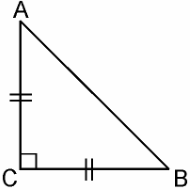
Given that ΔABC is an isosceles triangle right angled at C.
In ΔACB, ∠C = 90°
AC = BC (Given)
AB2 = AC2 + BC2 [By using Pythagoras theorem]
= AC2 + AC2 [Since, AC = BC]
AB2 = 2AC2
5
Answer

Given that ΔABC is an isosceles triangle having AC = BC and AB2 = 2AC2
In ΔACB,
AC = BC (Given)
AB2 = 2AC2 (Given)
AB2 = AC2 + AC2
= AC2 + BC2 [Since, AC = BC]
Hence, By Pythagoras theorem ΔABC is right angle triangle.
6
Answer

ABC is an equilateral triangle of side 2a.
Draw, AD ⊥ BC
In ΔADB and ΔADC, we have
AB = AC[Given]
AD = AD[Given]
∠ADB = ∠ADC[equal to 90°]
Therefore, ΔADB ≅ ΔADC by RHS congruence.
Hence, BD = DC [by CPCT]
In right angled ΔADB,
AB2 = AD2 + BD2
(2a)2 = AD2 + a2
⇒ AD2 = 4a2 - a2
⇒ AD2 = 3a2
⇒ AD = √3a
7
Answer

ABCD is a rhombus whose diagonals AC and BD intersect at O. [Given]
We have to prove that,
AB2 + BC2 + CD2 + AD2 = AC2 + BD2
Since, the diagonals of a rhombus bisect each other at right angles.
Therefore, AO = CO and BO = DO
In ΔAOB,
∠AOB = 90°
AB2 = AO2 + BO2 ... (i) [By Pythagoras]
Similarly,
AD2 = AO2 + DO2 ... (ii)
DC2 = DO2 + CO2 ... (iii)
BC2 = CO2 + BO2 ... (iv)
Adding equations (i) + (ii) + (iii) + (iv) we get,
AB2 + AD2 + DC2 + BC2 = 2(AO2 + BO2 + DO2 + CO2 )
= 4AO2 + 4BO2 [Since, AO = CO and BO =DO]
= (2AO)2 + (2BO)2 = AC2 + BD2
8
In Fig. 6.54, O is a point in the interior of a triangle
ABC, OD ⊥ BC, OE ⊥ AC and OF ⊥ AB. Show that
(i) OA2 + OB2 + OC2 – OD2 – OE2 – OF2 = AF2 + BD2 + CE2 ,
(ii) AF2 + BD2 + CE2 = AE2 + CD2 + BF2.
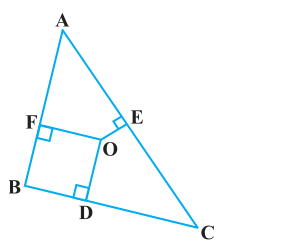
Answer
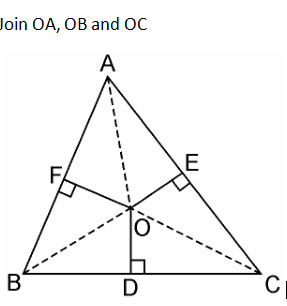
(i) Applying Pythagoras theorem in ΔAOF, we have
OA2 = OF2 + AF2
Similarly, in ΔBOD
OB2 = OD2 + BD2
Similarly, in ΔCOE
OC2 = OE2 + EC2
Adding these equations,
OA2 + OB2 + OC2 = OF2 + AF2 + OD2 + BD2 + OE2 + EC2
OA2 + OB2 + OC2 – OD2 – OE2 – OF2 = AF2 + BD2 + CE2.
(ii) AF2 + BD2 + EC2 = (OA2 - OE2) + (OC2 - OD2) + (OB2 - OF2)
∴ AF2 + BD2 + CE2 = AE2 + CD2 + BF2.
9
Answer

Let BA be the wall and Ac be the ladder,
Therefore, by Pythagoras theorem,we have
AC2 = AB2 + BC2
102 = 82 + BC2
BC2 = 100 – 64
BC2 = 36
BC = 6m
Therefore, the distance of the foot of the ladder from the base of the wall is 6 m.
10
Answer
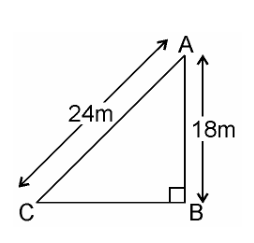
Let AB be the pole and AC be the wire.
By Pythagoras theorem,
AC2 = AB2 + BC2
242 = 182 + BC2
BC2 = 576 - 324
BC2 = 252
BC = 6√7m
Therefore, the distance from the base is 6√7m.
11
Answer
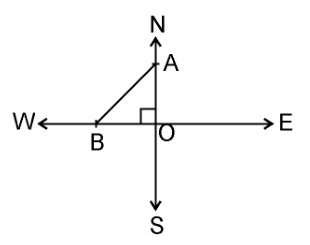
Speed of first aeroplane = 1000 km/hr
Distance covered by first aeroplane due north in 1 hours (OA) = 1000 × 3/2 km = 1500 km
Speed of second aeroplane = 1200 km/hr
Distance covered by second aeroplane due west in 1 hours (OB) = 1200 × 3/2km = 1800 km
In right angle ΔAOB, we have
AB2 = AO2 + OB2
⇒ AB2 = (1500)2 + (1800)2
⇒ AB = √2250000 + 3240000
= √5490000
⇒ AB = 300√61 km
Hence, the distance between two aeroplanes will be 300√61 km.
12
Answer
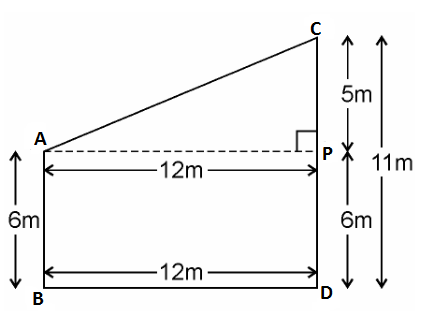
Let CD and AB be the poles of height 11 m and 6 m.
Therefore, CP = 11 - 6 = 5 m
From the figure, it can be observed that AP = 12m
Applying Pythagoras theorem for ΔAPC, we get
AP2 = PC2 + AC2
(12m)2 + (5m)2 = (AC)2
AC2 = (144+25)m2 = 169 m2
AC = 13m
Therefore, the distance between their tops is 13.
13
D and E are points on the sides CA and CB respectively of a triangle ABC right angled at C. Prove that AE2+ BD2= AB2 + DE2.
Answer
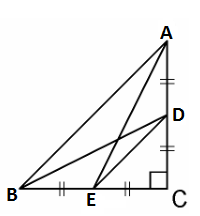
Applying Pythagoras theorem in ΔACE, we get
AC2 + CE2 = AE2....(i)
Applying Pythagoras theorem in ΔBCD, we get
BC2 + CD2 = BD2....(ii)
Using equations (i) and (ii), we get
AC2 + CE2 + BC2 + CD2 = AE2 + BD2...(iii)
Applying Pythagoras theorem in ΔCDE, we get
DE2 = CD2 + CE2
Applying Pythagoras theorem in ΔABC, we get
AB2 = AC2 + CB2
Putting these values in equation (iii), we get
DE2 + AB2 = AE2 + BD2.
14
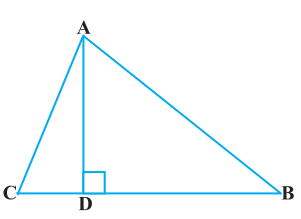
Answer
Given that in ΔABC, we haveAD ⊥BC and BD = 3CD
In right angle triangles ADB and ADC, we have
AB2 = AD2 + BD2...(i)
AC2 = AD2 + DC2...(ii) [By Pythagoras theorem]
Subtracting equation (ii) from equation (i), we get
AB2 - AC2 = BD2 - DC
= 9CD2 - CD2[∴ BD = 3CD]
= 9CD2 = 8[Since, BC = DB + CD = 3CD + CD = 4CD
Therefore, AB2 - AC2 =
⇒ 2(AB2 - AC2) = BC2
⇒ 2AB2 - 2AC2 = BC2
∴ 2AB2 = 2AC2 + BC2.
15
Answer
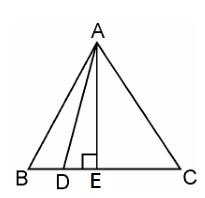
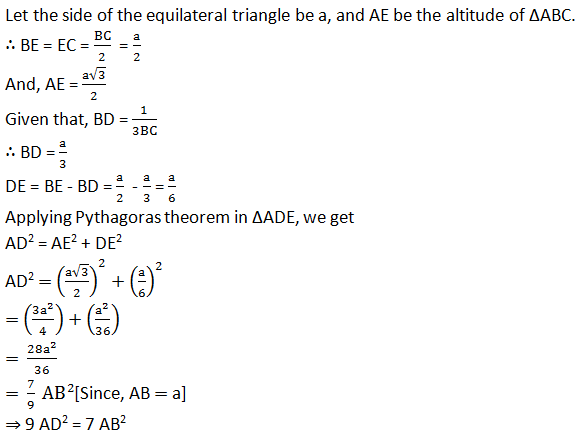
16
Answer
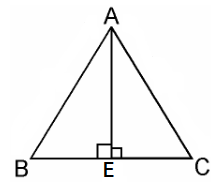
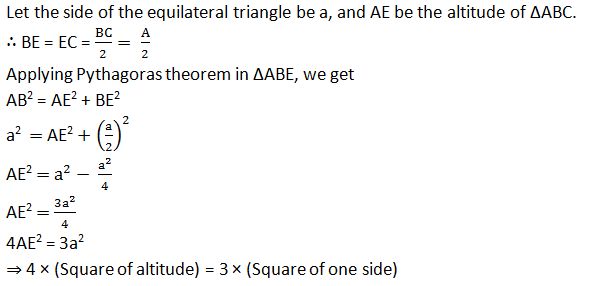
17
The angle B is:
(A) 120°
(B) 60°
(C) 90°
(D) 45°
Answer
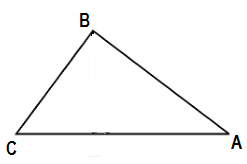
Given: AB = 6√3 cm, AC = 12 cm, and BC = 6 cm
We can observe that
AB2 = 108
AC2 = 144
And, BC2 = 36
AB2 + BC2 = AC2
The given triangle, ΔABC, is satisfying Pythagoras theorem.
Therefore, the triangle is a right triangle, right-angled at B.
∴ ∠B = 90°
Hence, the correct option is (C).
1
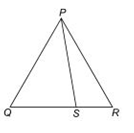
Answer
Given: In figure, PS is the bisector of ∠QPR of ∆PQR. Now, draw RT||SP to meet QP produced in T.∵ RT||SP and transversal PR intersects them
∴ ∠ 1 = ∠2 (Alternate interior angle)…(i)
∵ RT ||SP and transversal QT intersects them
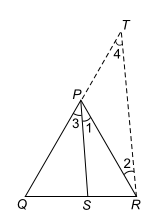
∴ ∠3 = ∠4 (Corresponding angle) …(ii)
But ∠1 = ∠3 (Given)
∴ ∠2 = ∠4 [From Eq. (i) and (ii)]
∴ PT = PR ….(iii) (∵Sides opposite to equal angles of a triangle are equal)
Now, in ∆QRT,
PS|| RT (By construction)

2
(i) DM2 = DN. MC
(ii) DN2 = DM. AN

Answer
Given: D is a point on hypotenuse AC of ∆ABC, DM⊥BC and DN⊥ AB .
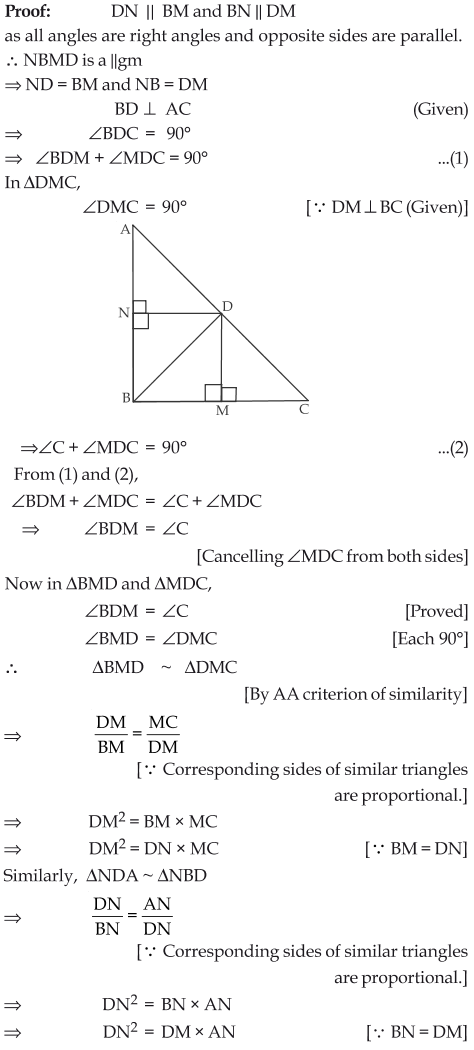
3
Prove that AC2 = AB2 + BC2=2BC .BD.
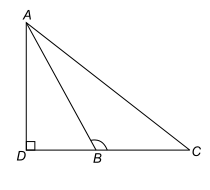
Answer
Given: In figure, ABC is a triangle in which ∠ABC> 90°and AD ⊥CB produced.Proof : In right ∆ABC,
∵ ∠D= 900
∴ AC2 = AD2 +DC2 (By Pythagoras theorem)
⇒ AC2 = AD2 +(DB2 + BC2) [∵ DC= DB+BC]
⇒ AC2 = (AD2+DB2 )+BC2 + 2DB.BC [∵ (a+b)2 = a2 +b2+2ab]
⇒ AC2 = AB2+BC2 +2DB . BC
∵In right ∆ADB with ∠D = 900 , AB2 = AD2+DB2 [By Pythagoras theorem)
4
Prove that AC2 = AB2 + BC2=2BC .BD.
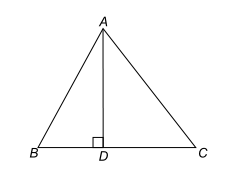
Answer
Given: In figure, ABC is a triangle in which ∠ABC< 90°and AD ⊥CB.Proof: In right ∆ ADC
∠D = 900
∴ AC2 = AD2+DC2 (By Pythagoras theorem)
⇒ AC2= AD2+(BC – BD)2 (∵ BC = BD+DC)
⇒ AC2= AD2 + BC2+BD2 –2BC . BD [∵ (a – b)2 = a2+b2 – 2ab ]
⇒ AC2= (AD2 +BD2)+BC2 –2BC . BD
⇒ AC2= AB2 +BC2 –2BC . BD
∵In right ∆ADB with ∠D = 900, AB2 = AD2+BD2 [By Pythagoras theorem)
5
In figure 6.60, AD is a median of triangle ABC and AM ⊥ BC. Prove that
(i) AC2 = AD2 + BC.DM+ (BC/2)2
(ii) AB2 = AD2 – BC.DM + (BC/2)2
(iii) AC2 + AB2 = 2AD2 + ½ BC2
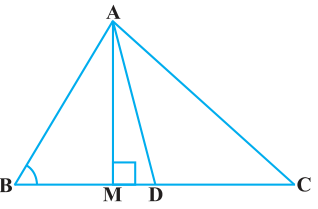
Answer
Given: In figure, AD is a median of a ∆ABC and AM⊥ BC.
Proof :
(i) In right ∆AMC,
∵ ∠M =90°
∴ AC2 = AM2+MC2 (By Pythagoras theorem)
∵ MC = MD+DC
⇒ AC2 = AM2+(MD+DC)2
⇒ AC2 = AM2 + MD2 +DC2 +2MD. DC [∵ (a+ b)2 = a2+b2+2ab ]
⇒ AC2 = (AM2 + MD2 )+ DC2 +2MD. DC
⇒ AC2 = AD2+ DC2 +2DC. MD
∵In right ∆AMD with ∠M = 90°,
AD2 = AM2+MD2 [By Pythagoras theorem)
(ii) In right ∆AMB,
∵ ∠M = 90°
∴ AB2 = AM2+BM2 (By Pythagoras theorem)
∵ BD = BM +MD
⇒ AB2 = AM2 + (BD – MD)2
⇒ AB2 = AM2 + BD2 +MD2 –2BD. MD [∵ (a – b)2 = a2 +b2 –2ab ]
⇒ AB2 = (AM2 +MD2)+BD2 – 2BD. MD
∵In right ∆AMD with ∠M = 90°,
AD2 = AM2+MD2 [By Pythagoras theorem)
⇒ AB2 = AD2 + BD2 – 2BD. MD
⇒ AB2 = AD2 + (1/2BC)2 – BC. MD [∵2BD = BC, (AD is a median of ∆ABC)]
∴ AB2 = AD2 + (1/2BC)2 – BC. MD … (ii)
(iii) On adding Eq. (i) and (ii), we get
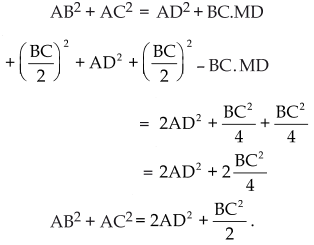
6
Answer
Given: ABCD is a parallelogram whose diagonals are AC and BD.
Now, draw AM⊥DC and BN ⊥ D (produced). Proof In right ∆AMD and ∆BNC,
AD= BC (Opposite sides of a parallelogram)
AM= BN (Both are altitudes of the same parallelogram to the same base)
∴ ∆ AMD≅ ∆ BNC (RHS congruence criterion)
∴ MD=NC (CPCT)…(i)
In right ∆BND,
∵ ∠N = 90°
∴ BD2 = BN2 +DN2 (By Pythagoras theorem )
⇒BD2 = BN2 +(DC+CN)2 (∵DN = DC+CN)
⇒BD2 = BN2 + DC2 +CN2 +2DC . CN [(a+ b)2 = a2+b2 +2ab]
⇒BD2 = (BN2+ CN2 )+ DC2 +2DC . CN
∵In right ∆BNC with ∠N = 900, BC2 = BN2+NC2 [By Pythagoras theorem)
⇒BD2 = BC2+ DC2 +2DC . CN …. (ii)
In right ∆AMC, ∠M= 90°
∴ AC2 = AM2 +MC2 (∵ MC = DC – DM)
⇒ AC2 = AM2 + (DC – DM)2 [(a+ b)2 = a2+b2 +2ab]
⇒ AC2 = AM2 + DC2 +DM2 –2DC .DM
⇒ AC2 = (AM2 + DM2) + DC2 –2DC .DM
∵In right ∆AMD with ∠M = 900, AD2 = AM2+MD2 [By Pythagoras theorem)
⇒ AC2 = AD2 + DC2 –2DC .DM
⇒ AC2 = AD2 + AB2 −2DC .CN … (iii)
(∵ DC = AB , opposite sides of parallelogram and BM= CN from Eq. (i)]
Now, on adding Eq. (iii) and (ii), we get
AC2 = (D2 + AB2 − 2DC .CN
BD2 = BC2+ DC2 +2DC . CN
⇒ AC2 + BD2 = (AD2 + AB2)+ (BC2+ DC2)
⇒ AC2 + BD2 = AD2 + AB2+BC2+ DC2
7
(i) ∆APC ~∆DPB
(ii) AP. PB =CP .DP
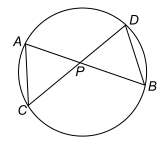
Answer
(i) ∆APC and ∆DPB
∠APC= ∠DPB (Vertically opposite angles)
∠CAP= ∠BDP (Angles in the same segment)
∴ ∆APC ~ ∆DPB (AA similarity criterion)
(ii) ∆APC ~ ∆DPB [Proved in (i)]![]()
⇒ AP. BP = CP . DP
⇒ AP. PB = CP. DP (Proved)
8
In figure 6.62, two chords AB and CD of a circle intersect each other at the point P (when produced) outside the circle. Prove that
(i) ∆PAC ~∆PDB
(ii) PA . PB = PC . PD
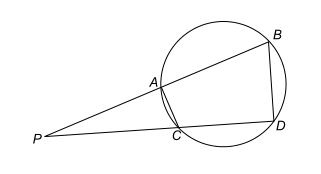
Answer
(i) We know that, in a cyclic quadrilaterals, the exterior angle is equal to the interior opposite angle.
Therefore, ∠PAC = ∠PDB …(i)
and ∠PCA = ∠PBD …(ii)
In view of Eq. (i) and (ii), we get
(∵ AA similarity criterion)
∆PAC ~ ∆PDB (Similar)
(ii) ∆PAC ~∆PDB [Proved in (i)]![]()
9
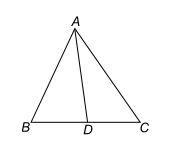
Answer
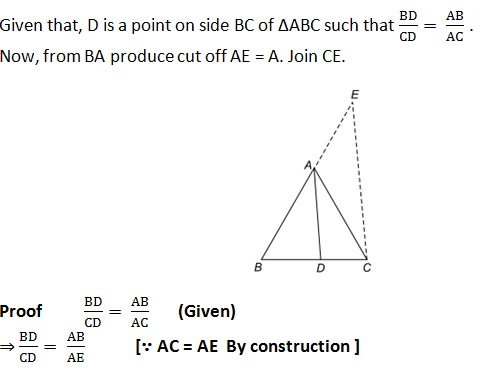
∴ In ∆BCE,
AD||CE (By converse of basic proportionality theorem)
∴ ∠BAD = ∠AEC (Corresponding angle) …(i)
and ∠CAD= ∠ACE (Alternate interior angle) …(ii)
∵ AC = AE (By construction)
∴ ∠AEC = ∠ACE …(iii)
(Angles opposite equal sides of a triangle are equal)
Using Eq. (i), (ii) and (iii), we get
∠BAD= ∠CAD
i.e., AD is the bisector of ∠BAC.
10
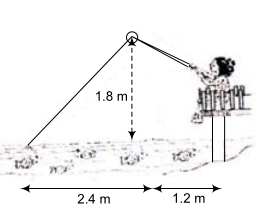
Answer
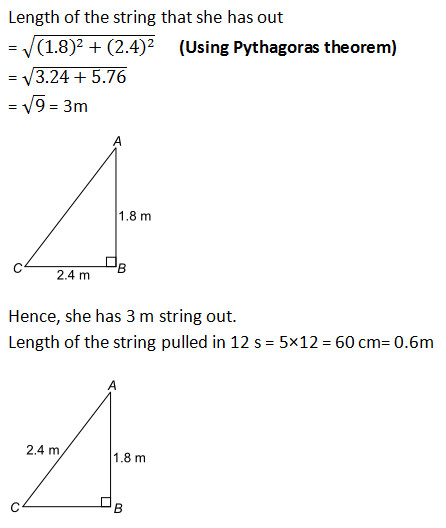
∴ Length of remaining string left out =3.0 −0.6 = 2.4m
BD2 = AC2 – AB2 (By Pythagoras theorem)
⇒ BD2= (2.4)2 – (1.8)2 = 5.76 – 3.24 = 2.52
